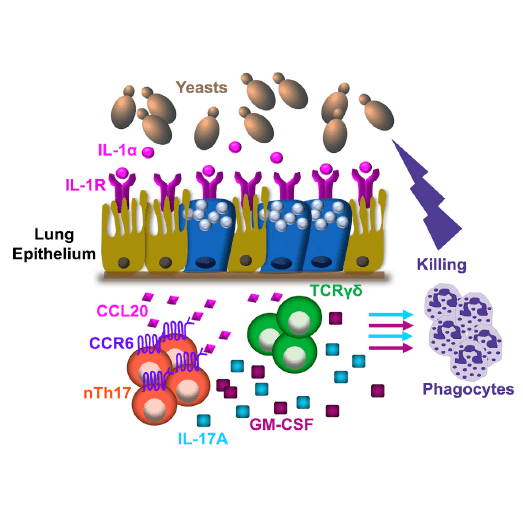Lung Epithelial Cells Coordinate Innate Lymphocytes and Immunity against Pulmonary Fungal Infection
4/20/2018
Nydiaris Hernandez-Santos, Darin L. Wiesner, J. Scott Fites, Andrew J. McDermott, Thomas Warner, Marcel Wuethrich, Bruce S. Klein.
In this featured paper, Hernandez-Santos et al. show that the lung epithelium guards against inhaled
fungi by providing early signals that orchestrate innate immunity.
Lung epithelial cells (LECs) are strategically positioned in the airway mucosa to provide barrier defense.
LECs also express pattern recognition receptors and a myriad of immune genes, but their role in immunity is often concealed by the activities of ‘‘professional’’ immune cells, particularly in the context of fungal infection.
Here, they demonstrate that NF-kB signaling in LECs is essential for immunity against a pulmonary fungal pathogen (blastomyces dermatitidis). LECs orchestrate innate antifungal immunity by augmenting the numbers of interleukin-17A (IL-17A)- and granulocyte-macrophage colony-stimulating
factor (GM-CSF)-producing innate lymphocytes, specifically ‘‘natural’’ Th17 (nTh17) cells. Innate lymphocyte-derived IL-17A and GM-CSF in turn enable phagocyte-driven fungal killing. LECs regulate the numbers of nTh17 cells via the production of chemokines such as CCL20, a process dependent
on IL-1a-IL-1 receptor (IL-1R) signaling on LECs. Therefore, LECs orchestrate IL-17A- and GM-CSF-mediated immunity in an IL-1R-dependent manner and represent an essential component of innate immunity to pulmonary fungal pathogens.
This means signaling via the lung epithelial cell receptor IL-1R is required to release soluble signals that coordinate and recruit innate lymphocytes whose soluble products arm phagocytes to kill fungi.
Read more in: Hernandez-Santos et al., 2018, Cell Host & Microbe 23, 511–522. April 11, 2018.

 Immune & Epithelial Interactions
Immune & Epithelial Interactions Allergy & Asthma
Allergy & Asthma





